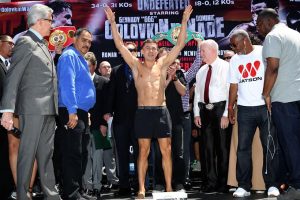GGG-Canelo: Where it goes could be a Texas-sized controversy
By Norm Frauenheim-

Then, there were two. Options for the Gennady Golovkin-Canelo Alvarez fight appear to be Las Vegas or Dallas. Sounds simple enough. Just follow the money.
But that old formula might get a little complicated because of politics. Like so much else during this polarized era, Dallas Cowboys owner Jerry Jones’ bid to stage the Sept. 16 fight at AT&T Stadium in Arlington, Tex., coincides with an increasingly contentious debate over immigration.
The day after the long-awaited fight was announced in the wake of Canelo’s beat-down of Julio Cesar Chavez Jr. at Vegas T-Mobile Arena on May 6, Texas Governor Greg Abbott signed SB 4 into law in a ceremony on Facebook Live.
Media reports refer to the bill as a “sanctuary cities ban.” Increasingly, however, it is being compared to another law, Arizona’s SB 1070, the 2010 legislation that required police to stop, question and, if necessary, detain people of being in the country illegally.
It was condemned for encouraging racial profiling. It was called the “Show Me Your Papers Law.’’ The same label has been applied to the Texas version, which mandates criminal and civil penalties for a failure to enforce SB 4, which goes into effect on Sept. 1.
It’s hard to know how the mounting controversy might affect negotiations for the fight. But the SB 1070 precedent indicates it will. Anger at the Arizona legislation resulted in direct hit on boxing in the state, where the sport has a long history. When the Arizona legislature passed the bill, the World Boxing Council’s (WBC) reaction was immediate.
The Mexico City-based WBC, then under late President Jose Sulaiman’s leadership, immediately condemned SB 1070. There were headlines in websites and newspapers that the WBC would ban boxing in Arizona for a law it compared to apartheid. For a while, Mexican fighters continued to cross the border and fight in the state, mostly at small casinos on Native American land near Tucson. No ban could really be enforced.
But damning publicity did real damage. It scared Mexican advertisers and television networks. At the height of the Arizona controversy, they stayed away from Hall of Famer Michael Carbajal’s home state. Oscar De La Hoya, Sugar Ray Leonard, Bernard Hopkins, Salvador Sanchez, Julio Cesar Chavez, George Foreman and Sonny Liston fought in Arizona, but the ring lights went dark for a couple of years because of SB 1070.
A month after Arizona passed the bill, Top Rank moved a card featuring then Phoenix prospect Jose Benavidez Jr., a former 140-pound champion, from Chandler, Ariz., to Chicago because Tecate and Azteca TV didn’t want to do business in the state.
For the next several months, boxers, media and promoters condemned SB 1070. Canelo promoter De La Hoya, of Golden Boy Promotions, called it racism.
“When that Arizona law went into effect, they weren’t really thinking about ‘This is meant for the European immigrants or this is meant for the Asian immigrants,'” De La Hoya told 15 Rounds before a Juan Manuel Marquez victory over Juan Diaz on July 31, 2010 at Vegas’ Mandalay Bay. “You know? And so, to a certain extent, I call it racism. I really do.”
De La Hoya, whose parents also came to the U.S. from Mexico, said he couldn’t do business in Arizona unless the law’s controversial elements were repealed.
In the seven years since its passage, the law has been amended. Arizona’s political climate has changed. Controversial Sheriff Joe Arpaio of Maricopa County (Phoenix) was voted out of office in a landslide. Just this week, they began tearing down Arpaio’s notorious jail, Tent City.
Meanwhile, boxing has returned to the state. Golden Boy staged an ESPN-televised card in Tucson on May 18. It plans to promote another one at Casino Del Sol on July 29. Top Rank featured Oscar Valdez Jr. in Tucson in 2015 and has talked about bringing him back for a defense of his WBO featherweight title. Valdez, a two-time Mexican Olympian, went to school in Tucson.
Arizona’s dormant boxing market is beginning to get beyond SB 1070. But the controversy is still there, loud and clear and perhaps magnified by the state that seems to make everything bigger. Dallas, the city that calls itself the Metroplex, is a finalist to stage GGG-Canelo. In a video bid for the bout, Jones said: “The idea of Canelo and GGG fighting before 100,000 screaming Hispanic Mexican fans is exciting.’’
A fight just 15 days after SB 4 goes into effect, however, makes it problematic. There are bound to be calls for a boycott of Texas by Latino leaders. The National Association of Latino Elected and Appointed Officials (NALEO) will meet in Dallas for three days next month, June 22-24. If the fight isn’t already on the agenda, it probably will be.
De La Hoya could make a statement and just decide to take his business to Vegas’ T-Mobile Arena. But there might be a statement in bringing Canelo-GGG to Dallas, too.
De La Hoya has already addressed opposition to President Donald Trump’s plans for a border wall with advertising for Canelo-Chavez Jr. that included video of both fighters crashing through an imaginary wall.
GGG-Canelo is more than just a big fight. It’s a big platform. If a crowd of 100,000 shows up for the bout, AT&T would be a city in its own right for one night. Maybe, a sanctuary city.